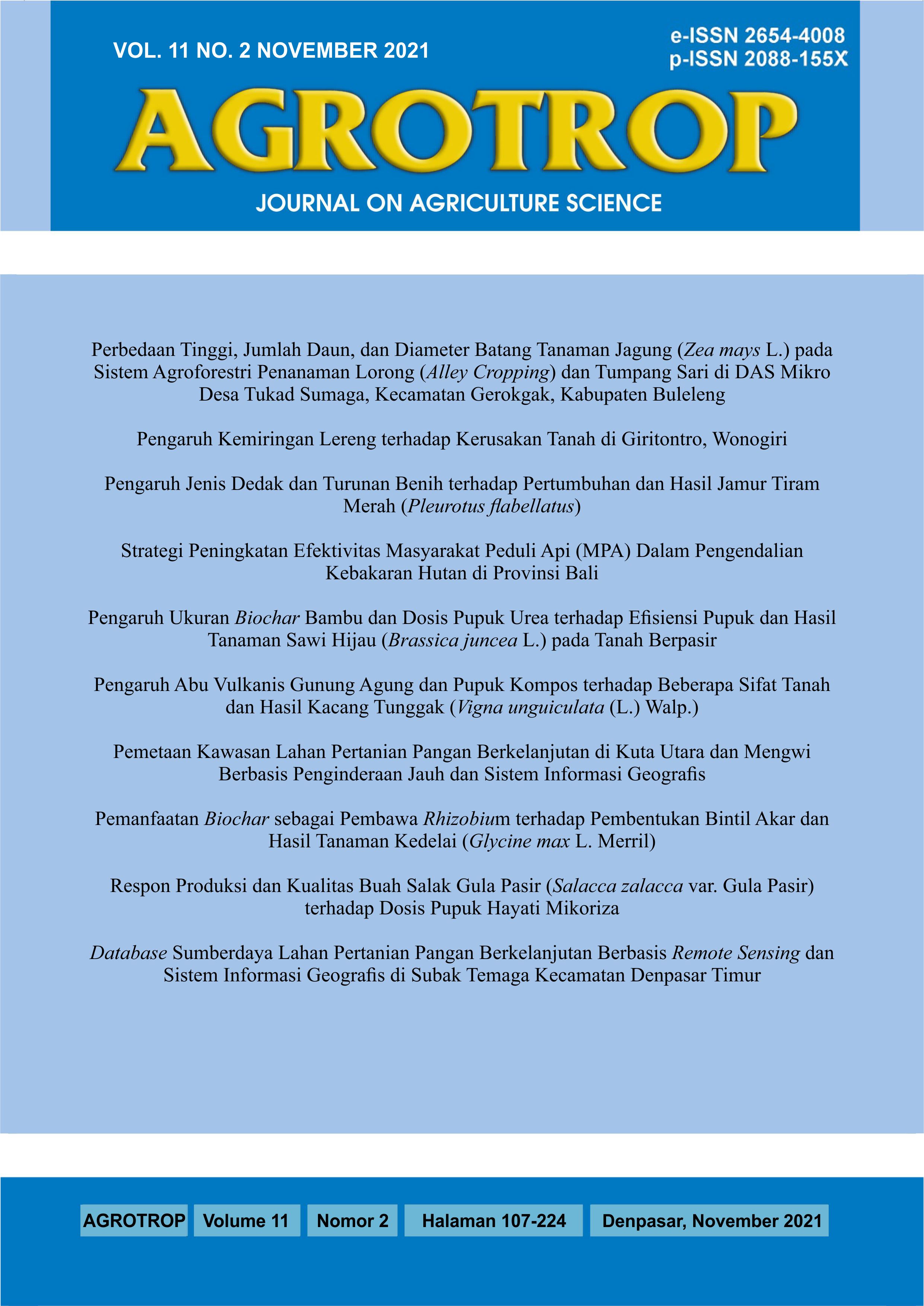Strategi Peningkatan Efektivitas Masyarakat Peduli Api (MPA) Dalam Pengendalian Kebakaran Hutan di Provinsi Bali
Abstract
Strategy For Improving Effectiveness of Fire Care Society (MPA) in Control of Forest Fire in Bali Province. Land and forest fires seem to be an annual disaster in Indonesia. The Ministry of Environment and Forestry is initiated to form Fire Care Community Groups, called Fire Care Society (MPA). MPA in Bali has been established since 2012. The study is needed to determine the community perception who live around the forest areas, to determine the effectiveness of MPA, and to analyzed strategic increases the effectiveness of MPAregarding forest fires controlling. Research data has been collected through a closed questionnaire to compile the respond of respondents in the google form. The respondent consisted of MPA member and non-member and related stakeholders. The types of data that been collected include respondent’s perceptions, MPA participation, and implementation of Perdirjen PPI number 3, 2018. These data then analyzed with the SWOT method. The results showed that the MPA and non-MPA members have positive perception of natural factor and human behavior as a factor of forest fires. The highest value of MPA’s participation in fires-fighting is 3.71 and participation influenced by environmental factors valued at 3.84. While the implementation of Perdirjen PPI decree is 66.39%. The SWOT analysis shows the MPA in progressive strategic S-O. So this study concludes that the MPA hasn’t been fully effective. The effectiveness can be improved by providing adequate support through clear regulations, budget allocations, and increasing human resource capacity.
Downloads
References
Alisjahbana, A S., & Jonah, M. B. (2017). Forestry, Forest Fires, and Climate Change in Indonesia. Bulletin of Indonesian Economic Studies, 53 (2): 111–136.
BNPB. (2013). Rencana Kontinjensi Nasional Menghadapi Ancaman Bencana Asap Akibat Kebakaran Hutan dan Lahan. Jakarta.
BPPIKHL Jawa Bali Nusa Tenggara. (2020). Statistik Tahun 2019. Kementerian Lingkungan Hidup dan Kehutanan. Bali.
David, L. A. G., Mohammad, A. S., Kristell, H., Bruno, L., Sean, S., Martin, W., Miriam, E M., Elis, M., Husna, Y., Ruth, D., Louis V., Daniel M., Robert, N., Peter, H., & Douglas, S. (2014). Major atmospheric emission from peat fires in Southeast Asia during non-drought years: evidence from the 2013 Sumatran fires. Sci Rep 4: 6112.Edward., Scott, A., Felix, H. 2015. Hazy Days: Forest Fires and the Politics of Environmental Security in Indonesia. Journal of Current Southeast Asian Affairs, 34 (3): 65–94.
Edward., Scott, A., & Felix, H. (2015). Hazy Days: Forest Fires and the Politics of Environmental Security in Indonesia. Journal of Current Southeast Asian Affairs, 34 (3): 65–94.
Elyarni, R., & Hermanto. (2016). Analisis SWOT Terhadap Strategi Pemasaran Layanan SAP Express pada PT. SAP. Jurnal Metris, 17: 81-88.
Evayanti, T., & Zulkarnaini. (2014). Partisipasi Organisasi Masyarakat Peduli Api (MPA) Terhadap Pencegahan dan Pengendalian Kebakaran Hutan dan Lahan di Kabupaten Pelalawan. Jurnal Ilmu Lingkungan, 8 (1): 1-11.
Fadlillah, N., Sambas, B., & Tutut, S. (2017). Pengendalian Kebakaran Hutan oleh Masyarakat Peduli Api (MPA) di Taman Nasional Gunung Ciremai. Media Konservasi, 21 (3): 216-224.
Földi, L., & Rajmund, K. (2016). Characteristics of Forest Fires and Their Impact on the Environment. AARMS, 15 (1): 5-17.
Harrison, M. E., Susan E. P., & Suwido, H. L. (2009). The Global Impact of Indonesian Forest Fires. Biologist 56 (3): 156-163.
Miettinen, J., Chenghua, S., & Soo, C. L. (2017). Fire Distribution in Peninsular Malaysia, Sumatra and Borneo in 2015 with Special Emphasis on Peatland Fires. Environmental Management, 60 (4): 747–757.
Nursoleha, P., Eva, B., & Satyanta, P. (2014). Zonasi tingkat kerawanan kebakaran hutan di Taman Nasional Gunung Ceremai (TNGC) berbasis sistem informasi geografi (SIG). Geo-Image, 3 (1): 1-4.
Peraturan Direktur Jenderal Perlindungan Hutan dan Konservasi Alam nomor 2 tahun 2014 tentang Pembentukan dan pembinaan Masyarakat Peduli Api.
Peraturan Direktur Jenderal Pengendalian Perubahan Iklim nomor 3 tahun 2018 tentang Pembentukan dan pembinaan Masyarakat Peduli Api.
Rangkuti, F. (2018). Analisis SWOT Teknik Membedah Kasus Bisnis. Cetakan Dua Puluh Empat. PT. Gramedia. Jakarta.
Rasyid, F. (2014). Permasalahan dan Dampak Kebakaran Hutan. Jurnal Lingkar Widyaiswara, 1 (4): 47-59.
Rezkisari, I. (2017). Puntung Rokok Jadi Penyebab Kebakaran Hutan Nagan Aceh. https://www.republika.co.id/berita/nasional/daerah/17/07/25/otmtt1328-puntung-rokok-jadi-penyebab-kebakaran-hutan-nagan-aceh diakses pada 2 Juli 2020.
Saharjo, B H., Lailan, S., Ati, D N., Erianto, I P., Robi, D W., & Wardana. (2018). Pengendalian Kebakaran Hutan dan Lahan di Wilayah Komunitas Terdampak Asap. IPB Press. Bogor.
Saharjo, B. H., & Guntala, W. (2017). Persepsi Masyarakat dalam Upaya Pengendalian Kebakaran Hutan di Taman Nasional Gunung Ciremai. Jurnal Silvikultur Tropika, 08 (2): 141-146.
Sawerah, S., Pudji, M., & Prabowo, T. (2016). Partisipasi Masyarakat dalam Pencegahan Kebakaran Lahan Gambut di Kabupaten Mempawah, Provinsi Kalimantan Barat. Jurnal Penyuluhan, 12 (1): 89-102.
Suyatra, P. (2017). Api Puntung Rokok Ludeskan Dua Hektare Hutan Lindung di Gerokgak. https://baliexpress.jawapos.com/read/2017/09/05/11805/api-puntung-rokok-ludeskan-dua-hektare-hutan-lindung-di-gerokgak diakses pada 2 Juli 2020.
Syaputra, M. (2018). Identifikasi Permasalahan dan Strategi dalam Pengelolaan Sampah di Jalur Pendakian Taman Nasional Gunung Rinjani. Jurnal Sangkareang Mataram, Vol 4 (2): 30-33.
Tacconi, L. (2003). Kebakaran Hutan di Indonesia: Penyebab, Biaya dan Implikasi Kebijakan. Center for International Forestry Research (CIFOR) Occasional Paper 38 (i). Bogor.
Tanjung, C. A. (2019). Buang Puntung Rokok, Sabri Jadi Tersangka Kebakaran Hutan. https://news.detik.com/berita/d-4380159/buang-puntung-rokok-sabri-jadi-tersangka-kebakaran-hutan diakses pada 2 Juli 2020.
Wade, C., & Carol, T. (2007). Psikologi. Edisi 9 Jilid 1. Erlangga. Jakarta.











